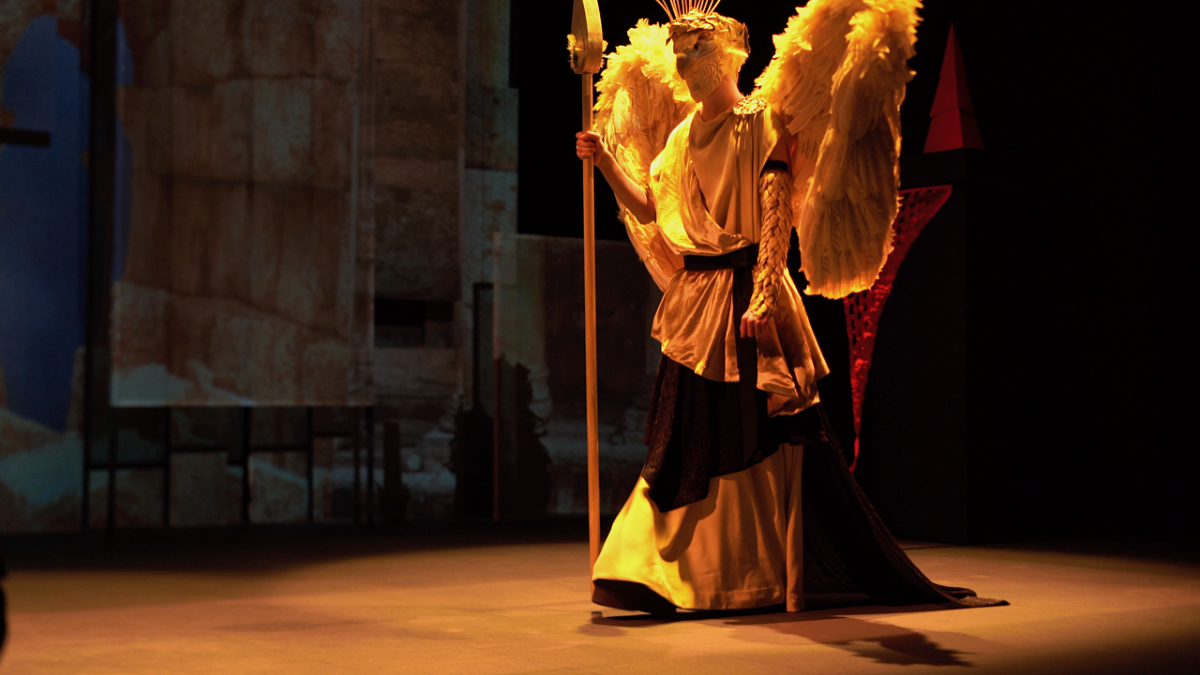February 12, 2021
Story by Claire Warner, CHC Communications
Video by Chris Nelson, CHC Communications
Brian McWhorter, associate professor of music in the Clark Honors College, sat on a box in a dark room Saturday evening, bopping his head back and forth. When the lights turned on, he looked at his friends with a grin on his face, wondering if they enjoyed the production that his orchestra produced music for.
McWhorter was unsure of what the show would look like when the director, John Schmor, professor of theatre arts, asked him if Orchestra Next, a training orchestra comprised of University of Oregon students and professors and the resident orchestra with the Eugene Ballet Company, could produce music for Personal Game, The production, which ran through Jan. 22-Feb. 6 at the University Theatre, featured MFA candidate Ashley Baker’s vibrant and distinctive costume designs, each performer considering the variety of avatars one might choose to use when playing a game, including doppelganger, idealized and experimental. What McWhorter did know was that the music would be wall-to-wall, meaning it begins at the start of the show and doesn’t stop until the end. McWhorter agreed to take on the project, which only allowed 12 audience members, socially distanced and wearing masks, for each 15-minute performance.
“The idea is these actors will come onto stage and embody these avatars in a variety of ways through movement and gesture,” McWhorter said before ever seeing the show.
Five musicians from McWhorter’s Orchestra Next produced music collaboratively through what McWhorter describes as a “telephone game.” Solely based on costume sketches, McWhorter chose a vibe and tempo for each portion of the show. He then sent this to the drummer, who developed rhythms for each. The drummer then forwarded this to the next musician, who improvised and recorded their part. The process continued until the music included drums, bass, keyboard, reeds and guitar.
“It was amazing,” McWhorter said about the finished product. “The music that came out of this thing was unexpected. I did not figure it was going to sound so good.”
Finally, McWhorter got to see the show at the production’s dress rehearsal. There was only one actor on stage at a time who moved about the stage in a way that mimicked the personality of the music and costume. The background of the stage displayed a variety of video clips and text to give context to the characters’ costumes.
“It was exhilarating,” he said. “I love how they’re moving to the music,” adding that he wanted to attend the show every night.
“The whole production was this weird game of chance,” he said. “We were putting the music together without knowing what was going to be on stage, without knowing much of anything. The actors were working on this stuff without knowing what the music was right away. Just to see how these disparate ideas came together and landed on stage... it was exhilarating”
This was not the first time McWhorter guided Orchestra Next through a challenging project during the coronavirus pandemic. At the onset of the pandemic in April, he and the rest of the orchestra realized they would not be able to perform their annual Nutcracker in collaboration with the Eugene Ballet.
“Every week the rules were changing and we were constantly ill prepared for what was coming next,” McWhorter said. “We were all improvising and trying to come up with projects. Our primary goal was to keep our musicians employed.”
Instead of rehearsing to perform the Nutcracker live, each of the Orchestra’s musicians recorded select parts of the Nutcracker from their homes individually. Each of the recorded movements added up to 20 minutes of music.
McWhorter and the other sound engineers uploaded the tracks into logic, an Apple recording software, and assembled them all so everyone’s audio was aligned. The team mixed the audio files to make it sound like the musicians were all playing together in the same space. This was a significant challenge because each musician had different recording equipment. McWhorter said that despite the time and hard work they invested, it could never sound the same as a live performance.
“We’ve become accustomed to hearing crappy audio through Zoom, so it doesn’t bother me. It resembles the time that we are in,” McWhorter said. “We’ll listen back and be like ‘oh yeah, that happened in 2020, the worst year in history.’”
Despite “crappy audio,” McWhorter ensured that every musician who submitted an audio file was included in the final recording.
“Our goal was to put everybody in,” McWhorter said. “It’s like a big family picture. Even if somebody’s not looking great, you put them in the picture anyway.”
McWhorter said there are additional benefits to playing all together that individual recordings cannot mimic.
“The whole thing about being a musician playing next to other people is that you vibe off of them” McWhorter said. “When you’re sitting next to someone, you can breathe with them, you feel their bodies and you play in concert with them.”
McWhorter said that because the musicians recorded themselves playing individually, the final product lacks the musicianship that comes with sitting next to somebody else.
“It’s a good reminder about what we value in music,” McWhorter said. “We want to get back to playing together because there’s just stuff you can’t do when you’re playing solo.”

